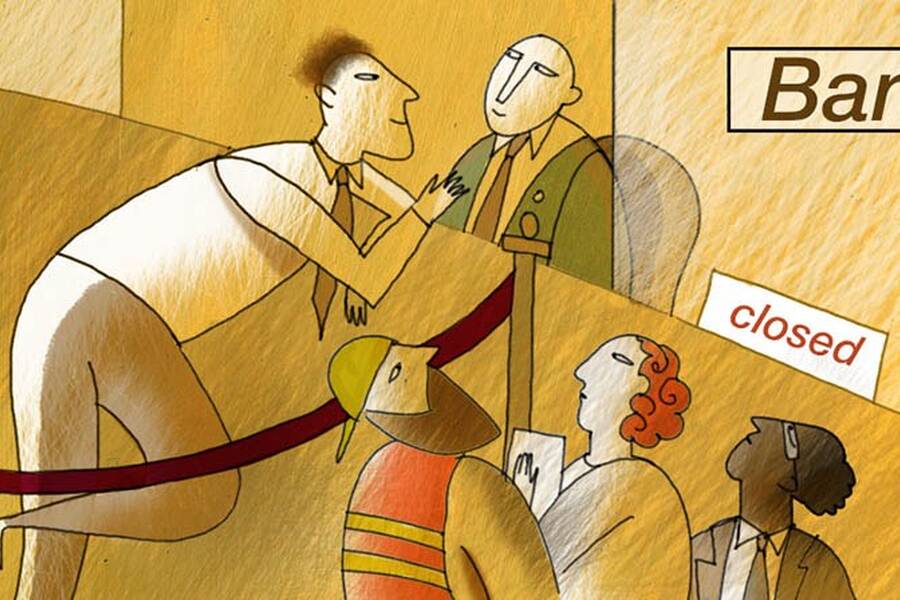
Riley Mann
In 2009, an economic shift took place in China that went largely unnoticed by Western researchers. The Chinese government implemented a stimulus program in response to the global recession, and the amount of money Chinese banks loaned to households and firms roughly doubled.
At the time, most economists outside of China were busy analyzing the recession’s effects on the United States and Europe, says Jacopo Ponticelli, an associate professor of finance at Kellogg. It wasn’t until 2015 that Ponticelli spotted a graph in the Financial Times that showed the jump in Chinese bank loans. He couldn’t help but wonder, “What happened to all this money?” Ponticelli says.
In particular, he wondered what kinds of firms had been on the receiving end of these new loans.
Often, Ponticelli says, a larger credit supply can lead banks to start extending loans to subpar companies. While that may bolster job opportunities in the short term, it can also keep inefficient companies afloat, hurting economic growth in the long run.
“These stimulus policies,” Ponticelli says, “can have unintended consequences that go beyond the temporary containment of the effects of the crisis.”
Had that happened in China? Ponticelli and his collaborators decided to investigate. They found that before the recession, banks generally gave loans to fairly productive firms. But after the stimulus program began, less productive companies received a larger increase in loans than productive companies—a trend that continued even after the program ended two years later.
Understanding the effect of the Chinese stimulus program is important because economic shifts in China can have global consequences. When the Chinese stock market crashed in 2015, for example, the Dow Jones Industrial Average plunged too. “Everyone realized that what happens in China has repercussions all over the world,” Ponticelli says.
Ponticelli hopes that the results will prompt other countries to exercise caution when implementing aggressive stimulus programs, especially since governments in other emerging economies, such as Brazil, have taken similar measures to prop up growth.
“This is not just a China story,” he says.
The Unintended Consequences of Credit Expansion
When the recession hit, the Chinese government announced a series of policies to increase the credit supply and encourage lending, such as loosening restrictions on the amount of money banks were required to keep in reserve. Freeing up more credit, the thinking went, would help finance infrastructure and social-welfare projects that would provide jobs.
To find out how these new policies affected lending, Ponticelli collaborated with Lin William Cong of the University of Chicago, Haoyu Gao of Renmin University of China, and Xiaoguang Yang of the Chinese Academy of Sciences.
The team obtained detailed loan data from the China Banking Regulatory Commission from 2006–2013. This covered about 80 percent of loans to companies from the 19 largest banks in the country. The researchers also obtained information about individual firms from the National Bureau of Statistics of China.
On a year-to-year basis, bank lending to firms increased by 5.6 trillion renminbi in 2009 (about $815 billion), more than twice the average increase observed in the previous two years, the team found. “2009 is off the charts,” Ponticelli says.
“You see capital and labor flowing faster toward less productive firms.”
While the lending was not concentrated in any particular sector of the economy, two clear patterns emerged when the researchers examined which kinds of firms received loans during this period.
First, the public sector benefitted more from the stimulus than the private sector. Indeed, once the stimulus began, state-owned companies saw an increase in lending that was 36 percent larger than what private companies enjoyed. Second, a disproportionate share of this new credit began flowing to less productive firms, whether state owned or private.
It might be reasonable to prop up less productive companies to preserve jobs during a recession, Ponticelli acknowledges—however, the fact that this effect outlasted the recession is “a little bit worrisome.”
Why Less Productive Firms Fared Better
The team came up with a couple of possible explanations for why the stimulus did less for private companies and highly productive firms.
For example, state-owned banks likely preferred to deal with state-owned firms. So if state-owned banks had responded more strongly to the credit stimulus, state-owned companies would have been more likely to benefit. However, the researchers did not find evidence that state-controlled banks increased their lending significantly more than other banks.
(Granted, it was hard to draw a hard line between private and state-owned banks in China. When the researchers tried to disentangle ownership structures, they nearly always found a thread leading back to the government or a state-owned firm, meaning they can’t rule out this hypothesis.)
The second possibility was that more loans went to state-owned firms because the banks figured they were more likely to get their money back. “This kind of loan will never go bust, because if the firm cannot pay, the government will step in,” Ponticelli says. For instance, the Chinese government saved state-owned China Eastern Airlines in 2008 but let East Star Airlines, a private company, sink into bankruptcy. And government support might be a particularly important factor for banks to consider during a recession, when they expect more firms to go under.
While the researchers couldn’t test this hypothesis directly, they did find some indirect evidence. Before the stimulus program, less productive firms were more likely than productive firms to default on loans. But after the program began, that was no longer the case, suggesting that the government had indeed bailed out underperforming companies during the recession.
“This time they didn’t experiment as they have often done in the past; they just went full-scale. That’s a riskier approach and harder to reverse.”
But why had unproductive private firms also benefited from the program more than productive firms?
While the researchers could not answer this question conclusively with the data, Ponticelli notes that even private companies in China often have links to central and local governments—and it’s possible that less productive ones were especially likely to have state support.
“If you’re less productive, how can you survive? Maybe you have a connection with the government,” he says.
A Better Monetary Stimulus Policy?
The researchers’ results point to a dramatic change in the Chinese economy as a result of the stimulus program. Between 2000 and 2008, capital began to be reallocated from older state-owned firms to more dynamic private firms, which many researchers believe helped drive China’s growth during this period. But post-stimulus, “you see a reversal of this process,” Ponticelli says. “You see capital and labor flowing faster toward less productive firms.”
While the researchers did not explicitly look at whether the Chinese economy suffered as a result of this reversal, economists agree that systematically misallocating loans can drive out productive firms in the long term. As such, Ponticelli sees the study as a cautionary tale for other countries considering using an influx of money to sustain a nation’s economy during a recession.
While there is no general formula for how governments should respond to economic crises, Ponticelli suspects that it might be better to introduce stimulus programs more gradually. In China, “there was a rush to try to avoid, at all costs, negative numbers in terms of GDP growth,” he says. “Maybe a more prudent approach at the beginning would have helped.”
Experimenting with a more limited credit expansion could have allowed officials to observe the effects and change course if needed. For instance, if the government saw that money was flowing to unproductive companies, perhaps they could have put the brakes on the program.
“But this time they didn’t experiment as they have often done in the past; they just went full-scale,” he says. “That’s a riskier approach and harder to reverse.”



